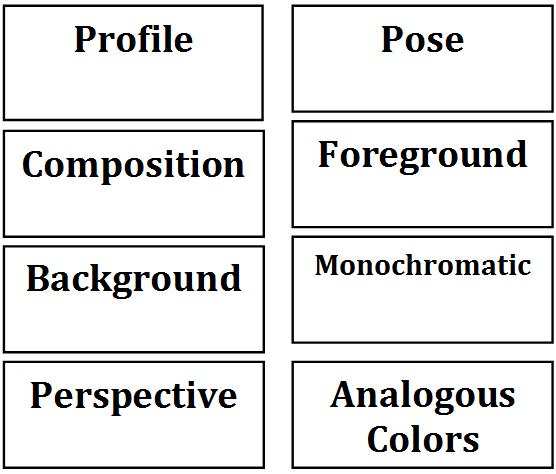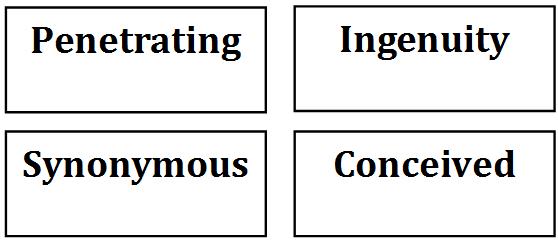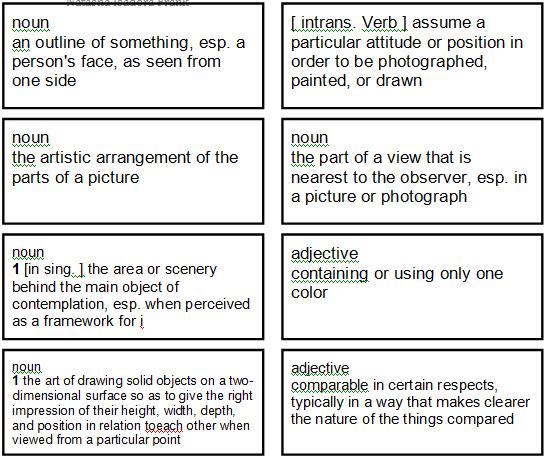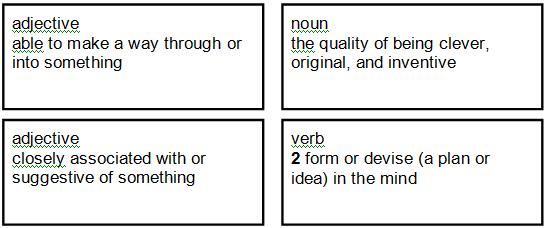Theme: Portraiture
Title: Children in Portraits: Capturing Youth
Skills: Vocabulary enrichment, reading, writing, speaking, and listening
General Goals:
The goal of this lesson is to acquaintstudents with child portraiture in general and John Singer Sargentís Portrait of a Boyin particular. To achieve this aim, students will learn how to describe portraits and perform a critical analysis of artworks. Having practiced these skills, the students will then compare the artworks of John Singer Sargent to those ofhis Russian contemporary, ValentinSerov.
Specific Objectives
After this lesson, the students will be able to:
- use twelve new vocabulary items;
- describe essential features of John Signer Sargentís biography;
- analyze John Singer SargentísPortrait of a Boy, using guided questions
- perform a comparative analysis of Sargentís portrait with ValentinSerovís portraits of children.
- practice writing a creative story about Homer, the subject of Sargentís portrait (homework).
Materials/ Visual Aids
- Reproduction of John Singer Sargentís Portrait of a Boy, 1890 (either on PowerPoint or as a handout)
- Appendices A, B, C, D, E, F, G, H, Iincluded with this lesson plan
Warm-up Activity: Introduction to Portraits of Children
- Explain to the students that you are going to examine the language of portraiture and then look at a John Singer Sargent portrait.
- Entire Class Activity: Activate the studentsí background knowledge by asking the following questions:
- Have you ever had a portrait painted or taken (photograph)?
- Why do you think people have their portraits painted or taken?
- What is the purpose of a portrait?
- What famous portraits do you know about?
- What are some differences between portraits of children and portraits of adults?
- Having finished this discussion, tell the students that you will now show them three pictures of child portraits. You can show these on PowerPoint or use handouts (Appendix A). Ask the students to look at each portrait and think of and write down at least five, descriptive adjectives. Give the students about one or two minutes to finish the task. When all the portraits have been shown, have the students share their words. Write these words on the chalkboard.
- Tell the students that, in addition, to the words that they have presented, they will now learn some more words related to portraiture. Move on to Activity 1
Activity 1: Vocabulary exploration and production
1. Introduce that following twelve words to the studentsósome of these words will be used for description; others will be used for understanding the reading text.

2. Once you have introduced the words, have the students play the vocabulary matching game. The directions for the game are printed on the worksheet (Appendix B).
3. When the students have finished playing the matching game. Put them in small groups Give each group a different image (from the warm-up activity; Appendix A). Ask them to write a short, one paragraph description of the portrait, using the new words. Have representatives of some of the groups share their descriptions with the class.
Activity 2: Introduction to John Singer Sargent
Activating Background Knowledge
1. Tell the students that now that they have learned some new vocabulary words they will get acquainted with the American artist John Singer Sargent. Show the students Sargentísportrait (Appendix C). Ask them the following questions:
- When do you think John Singer Sargent was born? How can you tell?
- Where do you think he lived and worked?
- Based on this image, how would you describe his personality?
2. Once the students have finished this discussion, ask them to check their predictions by reviewing the biographical information about Sargent (Appendix D).
Activity 3:† Introduction to Sargentís Portrait of a Boy, 1890.
Tell the students that now that they have learned about the artist, they will take a look at one of his portraits. Show the students SargentísPortrait of a Boy. Put students in small groups and tell them that they will do analysis of the portrait. (You might want to model the process using a different portrait). Distribute the Portrait Analysis Worksheet from the National Endowment for the Humanities (Appendix E). Have the students answer these questions about SargentísPortrait of a Boy. When they have finished, ask them to share their answers with the class.† To conclude the activity, ask the students to read an excerpt about the portrait from the Picturing America Teacherís Resource Book (p. 54); the excerpt is also reproduced in Appendix F. Have them compare their impressions with what was written. Thus, the students should answer the following questions:
- How does your analysis compare to that of the authorís?
- How are they similar?
- How are they different?
Activity 4: Comparative Analysis: Russian and American Portraits
Tell the students that now that they have learned about SargentísPortrait of a Boy, they can now compare Sargentís portrait to the Russian artist, ValentinSerov (1865-1911). Explain to the students that these two artists are roughly contemporaries and both of them painted portraits of children. Explain that for this activity the students will be making a poster. On this poster they will display one of Serovís portraits with Sargentís portrait. One the bottom they will write a comparative analysis of the two paintings. When they have finished, they will display their posters and perform a gallery walk. Give the students the following directions:
- Get into small groups.
- Each group will receive one of Serovís portraits (Appendix G).
- Before starting complete the comparative analysis worksheet (Appendix H).
- Write your analysis.
- Design your poster.
- Complete the gallery walk.
Gallery walk
For this activity, have the students display their posters. Make sure one member of the team is always standing by the posteróto answer questions from viewers. The other members can walk around to look at other posters. Team members should take turns standing by the poster and answering questions.
**** Modification to the activity:
If you are limited on space in your classroom, you can have the students present their posters to the class; naturally, this variation will take more time.
Homework
Now that the students have practiced analyzing paintings, have them analyze two of Sargentís painting of children. They can compare SargentísPortrait of a Boy with his paintingThe Daughters of Edward D. Boit.1882 (Appendix I).
Alternatively, the students could create a creative story about Homer in Portrait of a Boyand the
Extensions
- Have the students compare Homer in SargentísPortrait of a Boy with literary figures such as Tom Sawyer. The students can read a short excerpt of Tom Sawyer and compare Tomís personality with Homerís. Such an analysis could lead to a written or oral product. You can find the text of Adventures of Tom Sawyer on the project Gutenberg website: http://www.gutenberg.org
- Have the students watchMy Life As a Dogóthe 1985 Swedish movie directed by LasseHalistrom. The students can compare Homerís personality with Ingemarís (the main character of the film). A plot summary of the film can be found on the Internet Movie Database: (http://www.imdb.com) or on Wikipedia. The studentsí analysis could lead to a written or oral product.
References
Art Lex
http://www.artlex.com/
Internet Movie Database
http://www.imdb.com)
NEH Edusite
http://edsitement.neh.gov/
Olgaís Gallery
http://www.abcgallery.com/S/sargent/sargentbio.htmlwas
Picturing America
http://picturingamerica.neh.gov/
Project Gutenburg
http://www.gutenberg.org
Wikapedia
John_Singer_Sargent
http://en.wikipedia.org/wiki/John_Singer_Sargent
ValentinSerov
http://en.wikipedia.org/wiki/Valentin_Serov
Appendix A
Portraits of Children
Reproduce the following images either on Powerpoint or as a handout:
Pierre-AugusteRenior, Portrait of Claude Renoir Painting, 1907.
This image can be found at:
http://www.paintingmania.com/portrait-claude-renoir-painting-9_6750.html
Mary Cassatt, Children Playing on the Beach, 1884
This image can be found at:
http://www.artinthepicture.com/paintings/Mary_Cassatt/Children-Playing-on-the-Beach/
Ilya Repin, A Fisher Girl, 1874
This image can be found at:
http://www.abcgallery.com/R/repin/repin.html
Appendix B

Object of the Game
The object of this game is to get as many vocabulary words correct as possible. You will need to use your memory and your knowledge of the words.
Directions
Mix up all the cards. Set the cards face down on a flat surface. Turn over one card. Then try turn over another card. See if the word and the definition match. If they do match, you can keep the cards and have another turn. If not, give your partner a turn.
Rules
- Only turn over two cards at a time.
Post-game activity
When you have finished playing the vocabulary game, get into groups. Your teacher will give you on of the portraits of children that you looked at during the warm-up activity. Using the new words that you have just learned, write a short paragraph description of your image. Share your description with the class when you have finished.




Appendix C
Portrait of John Singer Sargent
Reproduce the following image either on Powerpoint or as a handout:
John Singer Sargent, Self-Portrait, 1906
This image can be found at:
http://jssgallery.org/Paintings/Self-Portrait_1907.htm
Appendix D
Biographical Information John Singer Sargent
- Born January 12, 1856 in Florence, Italy
- Died April 14, 1925 (aged 69) in London, England
- Nationality American (United States)
- Training: Field Painting Training Ecolenationalesuperieure des Beaux-Arts
- Works Influenced by Carolus-Duran, LeonBonnat, Diego Velazquez
John Singer Sargent, son of American expatriate parents, was born in Florence, Italy. He grew up in Europe, and studied painting in the Paris studio of the noted French portraitist Carolus-Duran and at the Ecole des Beaux-Arts. His first visit to the USA took place in 1876. He traveled much throughout Europe to study the art of different countries and times.
Among Sargent's first important clients in Paris were the Paillerons. He painted four portraits for them. EdouardPailleron, was a noted poet and playwright, and the son-in-law of the editor of a literary journal, Revue des deuxmondes. His wifeís family, the Bulozes, collected modern paintings. Sargent painted the portraits of both spouses in 1879.
At the 1884 Paris Salon, Sargent showed his now famous picture Madame X, the portrait of the 23-year-old American VirginieGautreau. Virginieís extravagant gown, bare shoulders, and arrogant manner, shocked the public. Critics found the picture eccentric and erotic. After this failure, Sargent dropped his hopes of establishing himself as a portrait painter in Paris. In 1886, he moved to London, where he spent most of his adult life, visiting America only on short trips.
During the next two years Sargent experimented with the Impressionist style. He was a close friend of Claude Monet, whom he painted sketching out of doors (Claude Monet Painting at the Edge of a Wood). Carnation, Lily, Lily, Rose was really the first piece of public impressionism to be produced in Britain, and for several years after its exhibition in 1887 it remained the most important example of the new style.
In 1888-1889, Sargent ďwas busy painting the play of light on sunlit water, catching the exact flicker, the ripple of the reflections and their fleeting effect on objects with range. He made several studies of his sister, Mrs Ormond, under those conditions: A Morning Walk, A Gust of Wind. These pictures show a delicacy of touch and a tenderness of color which give way to other qualities in his later work. The charm we see here is not the charm we are accustomed to look for in the work of subsequent years. It is more intimate and personal, more subtle and pervasive. Broken touches, here and there broken color, lightness of key, harmony of tone, unity of effect, and contrast reduced to its lowest terms.Ē (The Hon Evan Charteris: The Life of John Sargent. William Heinemann. p. 99)
In a few years Sargent became the most admired portrait painter in Britain and the United States. Sir Osbert Sitwell, who sat for Sargent with his family as a boy, summed up his popularity: ďÖlooking at his (Sargentís) portraits, they understood at last how rich they really wereÖ They had waited, among other things for Sargent to record them, and he snatched many of them from Timeís effacement; the aristocrat with his top hat and his riding whip, his handsome ramís head and air of dowdy elegance, the fashionable beauties who were beautiful but in so unstylized and fade a manner that it was almost impossible to formulate them upon canvas, and the fashionable beauties who were ugly and so much easier to paint. But all the women in his picture are richly clothed and all have the same harpiesí hands, grasping and ineffectual, with long grey-green talons, and hold, or allow to dangle, the same armís-length white kid gloves. Then there are the generals, the statesmen and the viceroys, and a ponderous and pondering author or two, with domed forehead and business manís jaw, looking out of presentation portraits inexpensive framesÖĒ
Sargent painted more than five hundred portraits. His mature portraits, e.g. Ena and Betty, Daughters of Asther Wertheimer, Mrs. Joseph Chamberlain, etc., showed little evidence of the broken touches of color he had used in the later eighties.
By 1907, Sargent got tired of portrait painting and accepted few commissions. He resumed his travels through Europe and to America. He painted constantly but turned to landscapes, producing more than 1,000 oils and watercolors. He also gladly accepted the more demanding challenge of murals for the Boston Public Library, for the Museum of Fine Arts and for the Widener Memorial Library at Harvard on which hestill working at the time of his death. Sargent died in London in 1925.†
Reference: Olgaís Gallery:
http://www.abcgallery.com/S/sargent/sargentbio.htmlwas
Appendix E
Portrait Analysis Worksheet
Hereís Looking at You, Kid
A Basic Guide to Portrait Analysis Based on a List of Questions
Used by Art Historians in Analyzing Portraiture
Describe the subject:
Gender and approximate age: ___________________________________ __________________________
Clothing:____________________________________________________ ____________________________
Pose (standing, sitting upright, relaxed, sprawled out, lying down, active):____________________
Does the subject appear to be looking at the viewer or at something else? If something else, at
what is the subject looking? ____________________________________ __________________________
How does the subjectís gaze make you feel about the subject? _______________________________
What kind of expression does the subject have? _______________________ _____________________
_____________________________________________ ____________________________________________
If you could ask the subject a few questions, what would they be? ___________________________
_____________________________________________ ____________________________________________
___________________________________________ ______________________________________________
If the subject could talk to you, what would he or she say? __________________________________
______________________________________________ ___________________________________________
Describe the type of the portrait:
Full-length, half-length, 3/4 length or bust (head and shoulders only)?_______________________
ĎSunday bestí or a relaxed portrait? What are the clues? (clothes, pose, expression, setting)
________________________________________________ _________________________________________
_____________________________________________________ ____________________________________
Describe the setting or background: __________________________________________ _____________
_____________________________________________________ ____________________________________
_____________________________________________________ ____________________________________
Is the background a backdrop (as in a modern-day photographerís studio or most school
photos) or a specific place? _______________________________________________________________
© 2001 National Endowment for the Humanities. Educators may reproduce this worksheet as needed for classroom use. http://edsitement.neh.gov
Describe the artistís style:
If a painting, is the portrait created to resemble a photograph? ______________________________
If the painting is not completely realistic, what parts are not realistic? How does the lack of
realism make you feel? __________________________________________________ _________________
__________________________________________________________________ _______________________
________________________________ ________________________________ _________________________
What colors stand out in the painting? ____________________________ ________________________
Other:
Does a particular feature stand out or catch your eye?________________ _______________________
What objects are included in the painting? Why do you think they were included? What do
the objects lead you to think about?____________________________ ___________________________
_____________________________ _____________________________ _______________________________
______________________________ ______________________________ _____________________________
______________________________ _______________________________ ____________________________
Summary:
What do you think this portrait was supposed to make you believe or feel about the subject?
How do you feel about the subject? Do you think you would like/admire the person if you
could meet? ________________________________________ _____________________________________
_________________________________________ ________________________________________________
________________________________________________ _________________________________________
_______________________________________________ __________________________________________
_______________________________________________ __________________________________________
________________________________________________ _________________________________________
________________________________________________ _________________________________________
_________________________________________________ ________________________________________
Hereís Looking at You, Kid: Portrait Analysis Worksheet Page 2
© 2001 National Endowment for the Humanities. Educators may reproduce this worksheet as needed for classroom use. http://edsitement.neh.gov
Appendix F
Reading TextPortrait of a Boy
John Singer Sargent
Portrait of a Boy, 1890
Excerpt from: NEH† Teacherís Resource Book (p. 54)
In Portrait of a Boy, ten-year-old Homer confronts the artist and viewer head-on and eye to eye with a† bored, yet penetrating glance, while behind him, and painted in a more summary manner, Augusta is absorbed in reading. Homer is dressed (uncomfortably, it appears) in a ďLittle Lord FauntleroyĒ suit, an outfit based on the title character from Frances Hodgson Burnettís wildly popular serialized story of Cedric, an American boy, who through Yankee ingenuity and the wisdom imparted by his mother, was able to lay claim to his aristocratic English heritage. Cedricís costume, derived from the attire worn by Thomas Gainsboroughís Blue Boy of c. 1770 was so popular with mothers that, by the turn of the century, wearing it became synonymous with being a ďmamaís boy.Ē
Homer, however, wearing his fancy suit, does not appear to be the obedient child listening to his motherís every word. We know from Homerís adult recollections of these sittings that Augusta was vainly attempting to entertain her son with the story of a navel battle from the War of 1812. Sargent expressed the boyís impatience and nervous energy not only through his pose but also through the structure of the composition. The child slumps sideways in the ornate studio chair. And while his right foot turns languidly inward, his left foot is braced against the rung, ready to spring. The latent energy of his spread, bent fingers matches the complexityof the swirling pattern of the red carpet, and this unease is intensified by Homerís pose, which is at a slight angle to both the viewer and to his mother.
Questions:
- How does your analysis compare to that of the authorís?
- How are they similar?
- How are they different?
Appendix G
Serov Portraits
Reproduce the following images either on Powerpoint or as a handout:
ValentinSerov. Girl with Peaches.Portrait of Vera Mamontova. 1887.
This image can be found at:
http://www.abcgallery.com/S/serov/serov17.html
ValentinSerov. Portrait of PraskovyaMamontova. 1889.
This image can be found at:
http://www.abcgallery.com/S/serov/serov7.html
ValentinSerov. The Children. Sasha &YuraSerov. 1899.
This image can be found at:
http://www.abcgallery.com/S/serov/serov.html
ValentinSerov. Mika Morozov. 1901.
This image can be found at:
http://www.abcgallery.com/S/serov/serov59.html
Appendix H
Comparative Analysis Worksheet

Directions
This worksheet is designed to help you prepare for your comparative analysis poster. By answering these questions, you will be able to create a clear paragraph.
Questions
Composition
How are the two compositions similar? Different?
Foreground
What is in the foreground of the two paintings? How are they similar? How are they different?
Background
What is in the background of the two paintings? How are they similar? How are they different?
Colors
What colors are used in each painting? How are they similar? How are they different?
Subject Matter
How are the children posed in each painting?
Children
How are the children dressed?
How would you describe their personalities?
How are they similar? How are they different?
Appendix I
John Singer Sargent Portrait
Reproduce the following images either on Powerpoint or as a handout:
John Singer Sargent.The Daughters of Edward D. Boit. 1882.
This image can be found at:
http://jssgallery.org/paintings/Daughters_of_Edward_Darley_Boit.htm |

